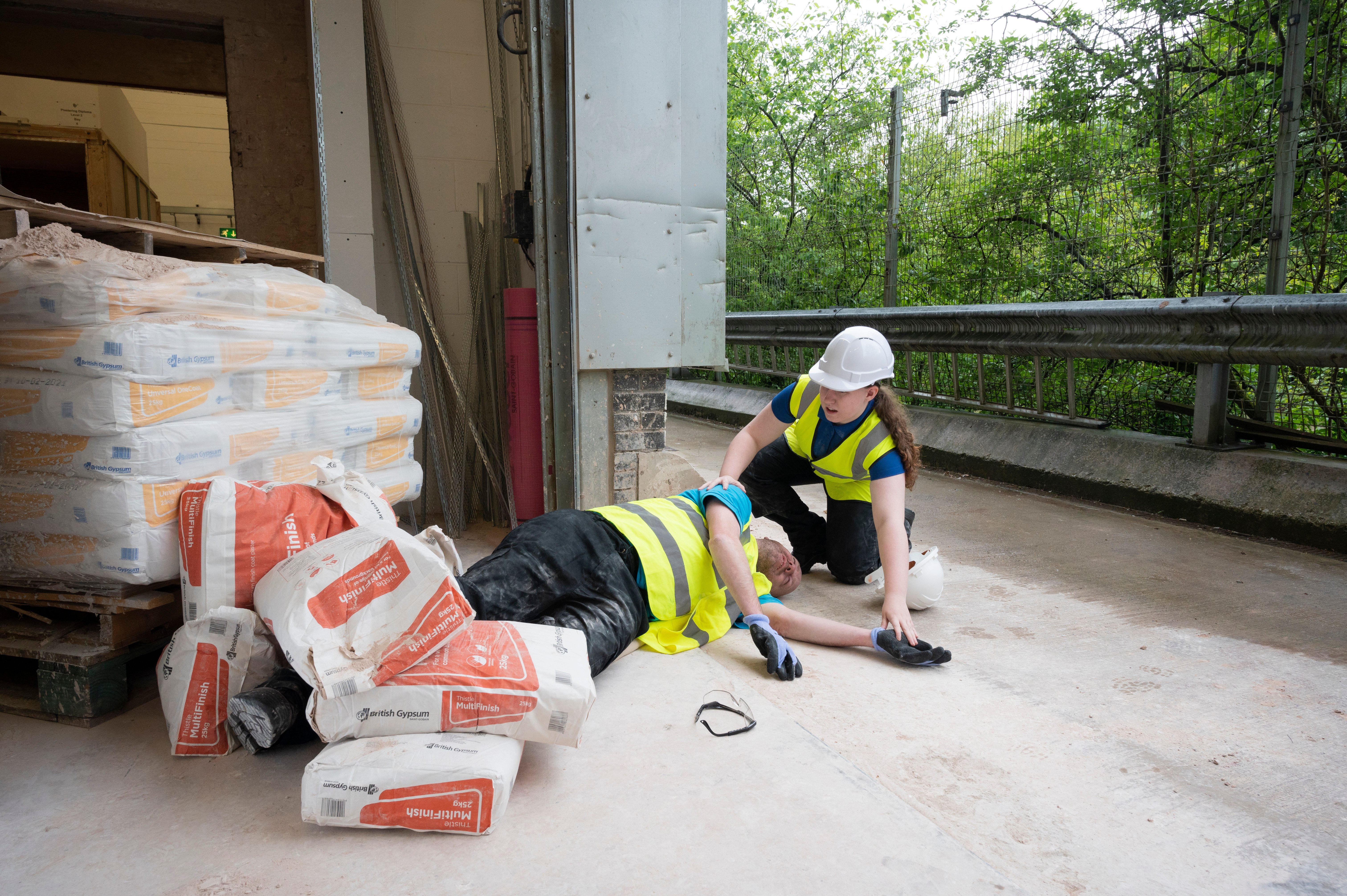In the construction industry, safety should always be a priority. Given its high-risk nature, complacency can pose significant risks.
First aid practices at construction sites help you protect yourself and your colleagues; there’s little margin for error, and having a confident and willing first aider on site can ensure a minor mishap doesn’t develop into a severe accident. First aid helps you mitigate risk, respond in times of trouble, and even save lives.
Safety challenges in the construction industry
Various safety risks can be attributed to the construction industry, and it's crucial to understand the need for robust safety measures.
The construction industry is one of the most hazardous. Whilst falls, machinery accidents, electrical incidents, and structural failures don’t necessarily happen all the time, they are common. Workers use heavy equipment, power tools, and scale scaffolds, so safety measures are essential.
Also, construction teams often consist of permanent employees, subcontractors, and temporary labourers. This makes it difficult to manage every individual on-site and ensure they’re adhering to safety protocols. Therefore, having multiple trained first aiders on site is crucial.
By embracing first aid training, you’ll be able to respond effectively in the event of an accident or medical emergency, take charge when it matters most, and protect your team.
How first aid provision helps address hazards on a construction site
There are hazards in the workplace that affect first aid provision, and prompt injury management is essential. Accidents can range from minor cuts and sprains to more severe incidents such as falls, electrical shocks, and machinery malfunctions.
Immediate and appropriate first aid can be the difference between a minor injury and in some cases, a life-threatening situation. Casualties can receive the care they need without delay if a first aider is on hand, reducing the likelihood of potential complications.
First aid training can also indirectly improve the morale of you and your team members. When staff know their safety and wellbeing are being prioritised, it can boost confidence and job satisfaction.
Browse our range of first aid courses designed to equip you and your team with invaluable skills
Discover comprehensive offerings that align with your organisation's safety goals.
How first aid for construction sites benefits workers
Workplace safety is a non-negotiable in the construction industry, and a first aid course can undoubtedly benefit you and your team.
It equips you with the skills and knowledge to respond promptly and effectively in emergencies and make a difference when it matters most.
By fostering a culture of first aid understanding and preparedness, you contribute to a safer work environment. When you’ve been trained properly, interventions become second nature.
The benefits of first aid training extend beyond personal preparation. As part of a team of confident first aiders, you collectively reduce risks throughout the project. This not only minimises disruptions but also improves overall productivity.
Do you need a first aider on a building site?
Company owners often ask, “How many first aiders do I need at work?”
In the construction industry, first aid training isn’t just a recommended practice; it is a regulatory requirement, and there’s a minimum level of first aid provision required.
You need to complete a first aid needs assessment to establish what qualifies as ‘adequate and appropriate’ first aid equipment and staffing for your company.
The Health and Safety at Work Act 1974 lays the foundation for a safe working environment for construction workers in the UK, while the Management of Health and Safety at Work Regulations 1999 specifically outlines the need for employers to assess and address the first aid requirements within their workplaces.
Furthermore, the Construction (Design and Management) Regulations 2015 require employers to consider and plan for first aid arrangements during the various project phases. This encompasses the provision of trained first aiders and the accessibility of first aid equipment and facilities.
To comply with these regulations, you need an adequate number of trained first aiders to be available on-site. The total will vary, depending on the size and specific risks associated with your project.
What first aid equipment is required on a construction site?
It’s vital to have the appropriate first aid equipment on construction sites to ensure you can administer first aid, should the need arise.
From minor incidents to more severe emergencies, having the right tools at hand can make all the difference in responding to a wide range of accidents, injuries, and illnesses.
First aid equipment may vary, depending on the outcome of the first aid needs assessment for your site, but commonly-used equipment includes:
- First Aid Kits
- Eye Wash Stations
- Resuscitation Equipment
- Emergency Blankets
- Tourniquets and Haemostatic Dressings (if staff have completed the associated training)
- Personal Protective Equipment (PPE)
Whilst it’s important to have this equipment available, care should only be administered by a qualified first aider.
Improve first aid at your construction site with Red Cross Training
Red Cross First Aid Training equips you with the knowledge and confidence you need to respond effectively and swiftly in emergencies.
In the construction industry, accidents are common and can be serious. Therefore, having a well-trained first aider who can respond without hesitation is essential.
Our 3-day First aid at work course includes modules to help you treat injuries commonly suffered in the construction industry.
For example, injuries involving embedded objects are unfortunately a real possibility in construction. During the training, this injury is replicated using props to demonstrate to learners how to respond should such a scenario occur.
If an object is embedded, you need to ensure the object isn’t removed. Instead, it’s important to keep the object in place and apply pressure around the area.
As part of the course, learners will be trained in how to apply specialised dressing to an embedded object wound, and how to apply sufficient packing and padding to restrict the movement of an embedded object.
With broken glass a likely hazard in construction sites and workers using tools to cut materials such as bricks, this further highlights the need for training on treating wounds with an object embedded in them and how to manage heavy bleeding.
It may be the case that you and your team have completed previous first aid training. However, the 2-day First aid at work requalification course is perfect for revising essential areas of first aid and refining your skills to ensure the care on your construction site is of the optimum standard.
We adopt a flexible approach, customising our methods to align with your preferred learning style.
By ensuring your staff are trained in first aid with the appropriate certification, you not only fulfil your legal obligations but also enable your teams to navigate emergencies with confidence ensuring that safety remains at the heart of your practice.
Topics: FAW Industry




